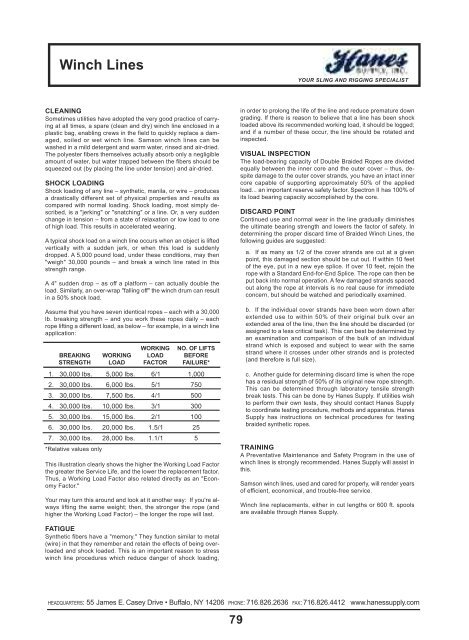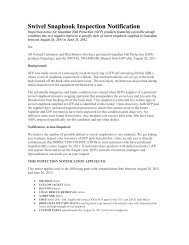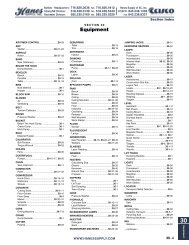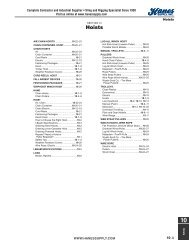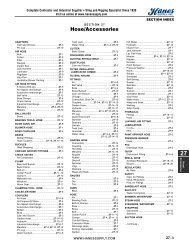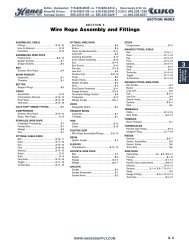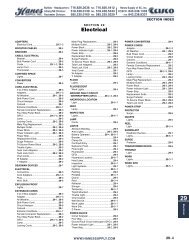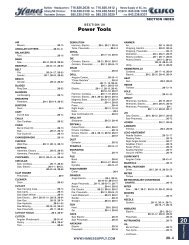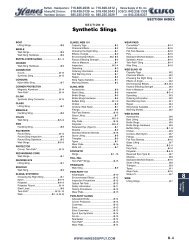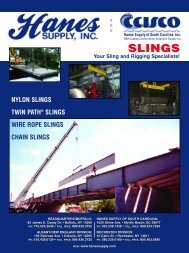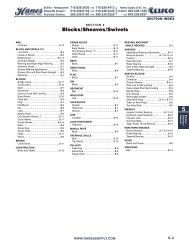twin-path® slings in action - Hanes Supply, Inc
twin-path® slings in action - Hanes Supply, Inc
twin-path® slings in action - Hanes Supply, Inc
- No tags were found...
You also want an ePaper? Increase the reach of your titles
YUMPU automatically turns print PDFs into web optimized ePapers that Google loves.
W<strong>in</strong>ch l<strong>in</strong>esYOUR SLING AND RIGGING SPECIALISTcleanInGSometimes utilities have adopted the very good practice of carry<strong>in</strong>gat all times, a spare (clean and dry) w<strong>in</strong>ch l<strong>in</strong>e enclosed <strong>in</strong> aplastic bag, enabl<strong>in</strong>g crews <strong>in</strong> the field to quickly replace a damaged,soiled or wet w<strong>in</strong>ch l<strong>in</strong>e. Samson w<strong>in</strong>ch l<strong>in</strong>es can bewashed <strong>in</strong> a mild detergent and warm water, r<strong>in</strong>sed and air-dried.The polyester fibers themselves actually absorb only a negligibleamount of water, but water trapped between the fibers should besqueezed out (by plac<strong>in</strong>g the l<strong>in</strong>e under tension) and air-dried.sHock loaDInGShock load<strong>in</strong>g of any l<strong>in</strong>e – synthetic, manila, or wire – producesa drastically different set of physical properties and results ascompared with normal load<strong>in</strong>g. Shock load<strong>in</strong>g, most simply described,is a "jerk<strong>in</strong>g" or "snatch<strong>in</strong>g" or a l<strong>in</strong>e. Or, a very suddenchange <strong>in</strong> tension – from a state of relaxation or low load to oneof high load. This results <strong>in</strong> accelerated wear<strong>in</strong>g.A typical shock load on a w<strong>in</strong>ch l<strong>in</strong>e occurs when an object is liftedvertically with a sudden jerk, or when this load is suddenlydropped. A 5,000 pound load, under these conditions, may then"weigh" 30,000 pounds – and break a w<strong>in</strong>ch l<strong>in</strong>e rated <strong>in</strong> thisstrength range.A 4" sudden drop – as off a platform – can actually double theload. Similarly, an over-wrap "fall<strong>in</strong>g off" the w<strong>in</strong>ch drum can result<strong>in</strong> a 50% shock load.Assume that you have seven identical ropes – each with a 30,000lb. break<strong>in</strong>g strength – and you work these ropes daily – eachrope lift<strong>in</strong>g a different load, as below – for example, <strong>in</strong> a w<strong>in</strong>ch l<strong>in</strong>eapplication:WoRkInG no. of lIftsbReakInG WoRkInG loaD befoRestRenGtH loaD factoR faIlURe*1. 30,000 lbs. 5,000 lbs. 6/1 1,0002. 30,000 lbs. 6,000 lbs. 5/1 7503. 30,000 lbs. 7,500 lbs. 4/1 5004. 30,000 lbs. 10,000 lbs. 3/1 3005. 30,000 lbs. 15,000 lbs. 2/1 1006. 30,000 lbs. 20,000 lbs. 1.5/1 257. 30,000 lbs. 28,000 lbs. 1.1/1 5*Relative values onlyThis illustration clearly shows the higher the Work<strong>in</strong>g Load Factorthe greater the Service Life, and the lower the replacement factor.Thus, a Work<strong>in</strong>g Load Factor also related directly as an "EconomyFactor."Your may turn this around and look at it another way: If you're alwayslift<strong>in</strong>g the same weight; then, the stronger the rope (andhigher the Work<strong>in</strong>g Load Factor) – the longer the rope will last.<strong>in</strong> order to prolong the life of the l<strong>in</strong>e and reduce premature downgrad<strong>in</strong>g. If there is reason to believe that a l<strong>in</strong>e has been shockloaded above its recommended work<strong>in</strong>g load, it should be logged;and if a number of these occur, the l<strong>in</strong>e should be rotated and<strong>in</strong>spected.VIsUal InsPectIonThe load-bear<strong>in</strong>g capacity of Double Braided Ropes are dividedequally between the <strong>in</strong>ner core and the outer cover – thus, despitedamage to the outer cover strands, you have an <strong>in</strong>tact <strong>in</strong>nercore capable of support<strong>in</strong>g approximately 50% of the appliedload... an important reserve safety factor. Spectron II has 100% ofits load bear<strong>in</strong>g capacity accomplished by the core.DIscaRD PoIntCont<strong>in</strong>ued use and normal wear <strong>in</strong> the l<strong>in</strong>e gradually dim<strong>in</strong>ishesthe ultimate bear<strong>in</strong>g strength and lowers the factor of safety. Indeterm<strong>in</strong><strong>in</strong>g the proper discard time of Braided W<strong>in</strong>ch L<strong>in</strong>es, thefollow<strong>in</strong>g guides are suggested:a. If as many as 1/2 of the cover strands are cut at a givenpo<strong>in</strong>t, this damaged section should be cut out. If with<strong>in</strong> 10 feetof the eye, put <strong>in</strong> a new eye splice. If over 10 feet, rejo<strong>in</strong> therope with a Standard End-for-End Splice. The rope can then beput back <strong>in</strong>to normal operation. A few damaged strands spacedout along the rope at <strong>in</strong>tervals is no real cause for immediateconcern, but should be watched and periodically exam<strong>in</strong>ed.b. If the <strong>in</strong>dividual cover strands have been worn down afterextended use to with<strong>in</strong> 50% of their orig<strong>in</strong>al bulk over anextended area of the l<strong>in</strong>e, then the l<strong>in</strong>e should be discarded (orassigned to a less critical task). This can best be determ<strong>in</strong>ed byan exam<strong>in</strong>ation and comparison of the bulk of an <strong>in</strong>dividualstrand which is exposed and subject to wear with the samestrand where it crosses under other strands and is protected(and therefore is full size).c. Another guide for determ<strong>in</strong><strong>in</strong>g discard time is when the ropehas a residual strength of 50% of its orig<strong>in</strong>al new rope strength.This can be determ<strong>in</strong>ed through laboratory tensile strengthbreak tests. This can be done by <strong>Hanes</strong> <strong>Supply</strong>. If utilities wishto perform their own tests, they should contact <strong>Hanes</strong> <strong>Supply</strong>to coord<strong>in</strong>ate test<strong>in</strong>g procedure, methods and apparatus. <strong>Hanes</strong><strong>Supply</strong> has <strong>in</strong>structions on technical procedures for test<strong>in</strong>gbraided synthetic ropes.tRaInInGA Preventative Ma<strong>in</strong>tenance and Safety Program <strong>in</strong> the use ofw<strong>in</strong>ch l<strong>in</strong>es is strongly recommended. <strong>Hanes</strong> <strong>Supply</strong> will assist <strong>in</strong>this.Samson w<strong>in</strong>ch l<strong>in</strong>es, used and cared for properly, will render yearsof efficient, economical, and trouble-free service.W<strong>in</strong>ch l<strong>in</strong>e replacements, either <strong>in</strong> cut lengths or 600 ft. spoolsare available through <strong>Hanes</strong> <strong>Supply</strong>.fatIGUeSynthetic fibers have a "memory." They function similar to metal(wire) <strong>in</strong> that they remember and reta<strong>in</strong> the effects of be<strong>in</strong>g overloadedand shock loaded. This is an important reason to stressw<strong>in</strong>ch l<strong>in</strong>e procedures which reduce danger of shock load<strong>in</strong>g,HEADQUARTERS: 55 James E. Casey Drive • Buffalo, NY 14206 PHONE: 716.826.2636 FAX: 716.826.4412 www.hanessupply.com79


